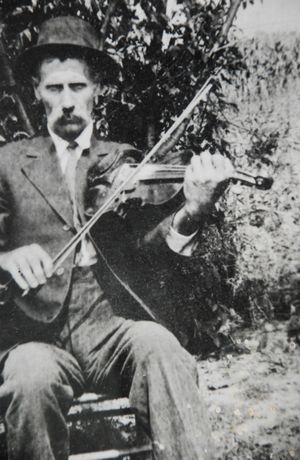Annotation:Iowa Center: Difference between revisions
(Created page with "[[{{BASEPAGENAME}}|Tune properties and standard notation]] ---- <p><font face="garamond, serif" size="4"> '''IOWA CENTER'''. Old-Time, Piece. USA, Kentucky. G Major. Standard tun...") |
No edit summary |
||
| (13 intermediate revisions by 3 users not shown) | |||
| Line 1: | Line 1: | ||
[[{{BASEPAGENAME}} | __NOABC__ | ||
<div class="noprint"> | |||
<p><font face="Century Gothic" size="4"> Back to [[{{BASEPAGENAME}}]] </font></p> | |||
</div> | |||
---- | ---- | ||
<p><font face=" | {{#lst:{{PAGENAME}}|abc}} | ||
---- | |||
<div style="page-break-before:always"></div> | |||
<p><font face="Century Gothic" size="3"> | |||
<div style="text-align: justify; direction: ltr; margin-bottom: 90px; margin-left: 70px; margin-right: 120px;"> | |||
<br> | <br> | ||
'''IOWA CENTER'''. American, Listening Air (cut time). USA, Kentucky. G Major. Standard tuning (fiddle). AB. Kentucky fiddler [[biography:Clyde Davenport]] [http://www.fieldrecorder.com/docs/notes/davenport.htm] (1921-) was the only source for this tune, explains Titon (2001), which is played at a slow, listening pace. Titon believes some of the "swooping cadences" recall those in "[[Lost Girl]]." | |||
<br> | <br> | ||
<br> | |||
</div> | |||
</font></p> | </font></p> | ||
<p><font face=" | <div class="noprint"> | ||
''Source for notated version'': Clyde Davenport (Monticello, Wayne County, Ky., 1990), learned from his father, Will Davenport [Titon]. | <p><font face="Century Gothic" size="3"> '''Additional notes''' </font></p> | ||
<p><font face="Century Gothic" size="3"> | |||
[[File:Willdavenport.jpg|thumb|Will Davenport (b. 1876), Clyde Davenport's father.]] | |||
<font color=red>''Source for notated version''</font>: - Clyde Davenport (Monticello, Wayne County, Ky., 1990), learned from his father, Will Davenport [Titon]. Fiddle and banjo player Will Davenport was born in 1876, the son of Francis Marion Davenport who also was a fiddler. Clyde also had three brothers who played the fiddle. The family band was in demand for dances when he was younger; Clyde played the banjo while the brothers played fiddle. | |||
<br> | <br> | ||
<br> | <br> | ||
</font></p> | </font></p> | ||
<p><font face=" | <p><font face="Century Gothic" size="3"> | ||
''Printed sources'': | <font color=red>''Printed sources''</font> : - Titon ('''Old-Time Kentucky Fiddle Tunes'''), 2001; No. 70, p. 100. | ||
<br> | <br> | ||
<br> | <br> | ||
</font></p> | </font></p> | ||
<p><font face=" | <p><font face="Century Gothic" size="3"> | ||
''Recorded sources'': <font color=teal>Berea College Appalachian Center AC002, Clyde Davenport - "Puncheon Camps" (1992).</font> | <font color=red>''Recorded sources'': </font> <font color=teal> -Berea College Appalachian Center AC002, Clyde Davenport - "Puncheon Camps" (1992). Field Recorders Collective FHR 103 & 104, "Clyde Davenport" | ||
</font> | |||
</font></p> | </font></p> | ||
<br> | <br> | ||
---- | ---- | ||
[[{{BASEPAGENAME}} | <p><font face="Century Gothic" size="4"> Back to [[{{BASEPAGENAME}}]] </font></p> | ||
</div> | |||
__NOEDITSECTION__ | |||
__NOTITLE__ | |||
Latest revision as of 03:31, 15 January 2020
X:1 T:Iowa Center N:From the playing of fiddler Clyde Davenport (Ky.) N:Davenport (b. 1921) was born in Blue Hole Hollow, near Mt. Pisgah on the N:Cumberland Plateau in south-central Kentucky, not far from the border with N:Tennessee. M:C| L:1/8 R:Reel Q:"Moderate, walking pace." D:https://www.slippery-hill.com/recording/iowa-center D:Berea College Appalachian Center AC 002, Clyde Davenport - Puncheon Camps (1992) Z:Transcribed by Andrew Kuntz K:G D2-G2|: B-d e2 d-BG2| B-d e2 d-Bde| e2 de dBAG |B-d e2 d-BG2| B-d e2 dB d>e |dBAG ([GB]>[AB])[G2B2]-|[G4B4]Bde2|[e4e4] efge| |1dB AG([GB]>A)G2:|2dB AG ([GB]>A)[G2B2]-|[M:3/4][G4B4]|| [G,2D2]-|[M:C|][G,2D2]g3a g-a|b/ag/-gB [G,4G4]-|[G,2G2] ef g2ga|gaab bb2d-| d6ef |g2g3a ga| ba-ag-g2 ga| ba g2 efge|dBAG ([GB]A) G2||
IOWA CENTER. American, Listening Air (cut time). USA, Kentucky. G Major. Standard tuning (fiddle). AB. Kentucky fiddler biography:Clyde Davenport [1] (1921-) was the only source for this tune, explains Titon (2001), which is played at a slow, listening pace. Titon believes some of the "swooping cadences" recall those in "Lost Girl."

